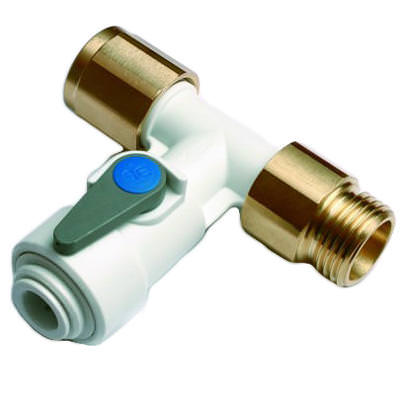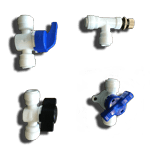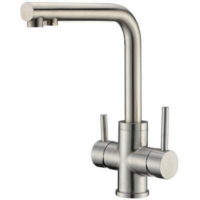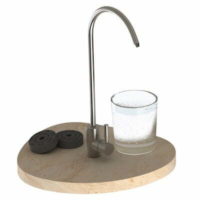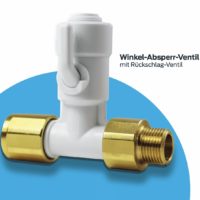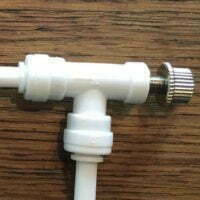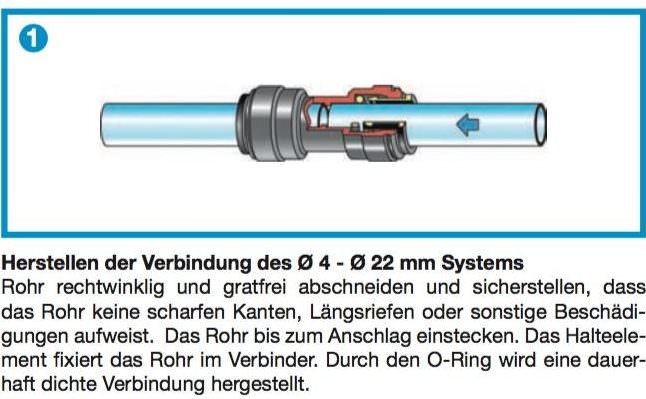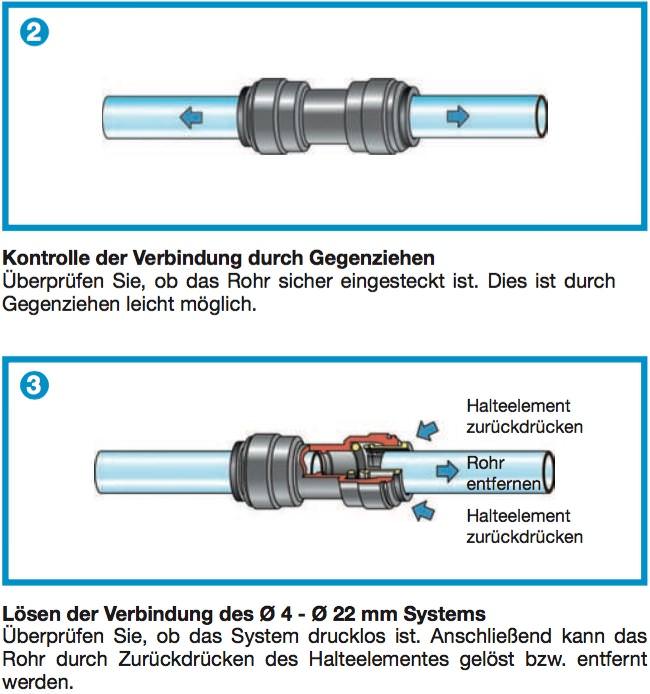Accessories for water ionizers and water filters
Installation parts | Water ionizer | Water filter | Reverse osmosis systems
Crash course in flameproof connectors
We will be happy to help you if you have not found the right connector or adapter part on our website. Avoid a trip to the hardware store or researching online as you will rarely find the connectors we have available. You have little chance, especially in the hardware store.
We have specialized in the field of water filtering for 30 years, so it's best to ask us first by email or WhatsApp to send a few photos:
water@aquacentrum.de and WhatsApp number: +491792166231
Results 1 - 12 of 28 are displayed
Results 1 - 12 of 28 are displayed
Questions and answers | Installation variants water ionizer | Water filter | Undertable ionizer
> Installation of water ionizer
> Installation of water ionizer
Procedure for installing the quick-fitting connectors:
Connecting the Ø 6,35 mm (1/4”) system
Cut the pipe squarely and without burrs and ensure that the pipe has no sharp edges, longitudinal grooves or other damage. Insert the pipe into the quick fitting as far as it will go. The holding element fixes the pipe in the connector. The O-ring creates a permanently tight connection.
Check the connection by counter-tightening
Check that the pipe is inserted securely. This is easily possible by counter-pulling.
Disconnecting the Ø 6,35 mm (1/4”) system
Check that the system is depressurized. The pipe can then be loosened or removed by pushing back the holding element.
On June 27.06.2016, 22 at 37:XNUMX p.m. Daniel S. wrote:
Dear Mr. Akgün,
First of all, thank you for your offer. ..
..However, I am also interested in a water ionizer without a filter unit, because then I already have filtered water. Preferably under the table, but on the table is also ok. Can you recommend one to me? Price is secondary.
Then I am interested in your whirlpool shower. To be honest, I'm not sure if it should be one of yours or Aquadea's. At the moment I can't explain what real benefit precious metals and gemstones have on shower water. I know the theory, but in practice I couldn't tell any difference with the whirler for the rooster.
Kind regards, Daniel S.
Hello Mr. S.,
Yes, that's good news.
OK, you want to go with that Morion reverse osmosis system filter, this is also the only reverse osmosis that I recommend over an ionizer, as your tank pressure for the small tank uses the tap water pressure, and does not have a rubber membrane like other tank RO systems, where there is an air cushion that depends delivers more or less pressure depending on the filling level of the tank.
And direct-flow systems do not provide the necessary counterpressure. Unless you have an ionizer whose filter you have removed or capped.
But well, I would recommend, because of the taste alone, after mineralizing through filter 1 of the EOS Revelation, I freshly received the mineral filters.
Exactly for your case, people with a RO system in front of the water ionizer.
Directly from the manufacturer of EOS.
And we cut off the other filter. To do this, we have to open the system and then keep the removed filter as our service expense.
So no costs for you.
Otherwise we can remove both filters and you have the best under-sink system, but without a filter, the EOS Revelation:
http://www.aquacentrum.de/shop/eos-revelation-ll-wasserionisierer-untertisch/
This only works with the Revelation, not with the other EOS devices because they have a filter chip.
It would work, but then you would have to get filter chips.
And they would have to change the chip every 3000 liters
Because of the swirl shower:
I know the Aquadea shower heads because I was able to try them out several times.
Would you rather have a soft, full shower experience or would you rather have a harder one?
I also know the old VitaVortex shower heads, the company is now called something different, CARAT Aqua Plus, none of the whirl shower heads in the premium range come close to the new one Magic 7 from CARAT Aqua Plus (formerly VitaVortex) approach. Such a lovely shower experience that you won't want to get out of the bathroom. That's why I only shower every few days, otherwise I would spend half my life in the shower.
No, joking aside. Simply test it, if it doesn't fit, send it back and we will refund 100% of the amount paid:
www.aquacentrum.de/spezialcontentsguarantee/
Hope this helps you
All the best
Yours, Yasin Akgün
Installing water ionizer on the faucet
A rotary control on a water ionizer is only an advantage in a faucet installation compared to the water ionizers with a solenoid valve and an on-off control (e.g EOS Genesis or EOS Touch), which is connected to an external Flow regulating valve be delivered.
Only the AquaVolta Moses-7 water ionizer, which is the successor of Nexus X-Blue water ionizer, AquaVolta Basic and the Allsbon Family have a rotary valve integrated into the front of the device housing. This is particularly useful in everyday practice, especially when installing faucets, as the flow has a major influence on the end result.
This is explained again in the operating and filter changing video in this FAQ article, which is analogous Flow regulating valve in the Permanent installation used to set the appropriate flow.
Of course, it is ideal if you can see the current flow on the water ionizer display. That's just at AquaVolta Moses-7 and at Allsbon Dion Family is possible.
Link this post | Link to the post
Water ionizer installed under the sink counter with its own tap, is there any disadvantages?

Installing an under-sink ionizer requires more installation effort. In most cases, however, a simple hole in the flush plate is sufficient. This is all possible, talk to us.
It looks particularly elegant thanks to the control tap on the unit, which can also be installed under the table Dion Special Convertible Water ionizer clarifies:
It is rumored that under-sink ionizers have a disadvantage because the water stays in the ionizer and cannot drain away. Our experience was that no problems arose with the Ionquell Delphi, which is now over 5 years old, even after intensive use and calcification of the alkaline water outlet. You just have to descale regularly. The alternative, which certainly has no disadvantage, is this AquaVolta EOS Revelation, which reverses itself after production and then rinses out the remaining water with filtered, non-alkaline water.
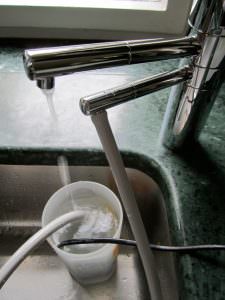
The following is an excerpt from Karl Heinz Asenbaum's FAQs, which he has compiled experimentally and through a lot of research since 2005:
The two problems of under-table ionizers (calcification of the spout and risk of germ contamination) can be solved using the method developed by Dipl.-Ing. Solve the operating process invented by Yasin Akgün. After bottling, you switch to the acidic level for a few seconds. In view of the problems, there is unproblematic, lime-free and non-gluing water in the outlet column. I have been testing an Allsbon Dion under-table ionizer at home for 6 months. There are actually no problems whatsoever despite hard water.
The illustration shows how easy it is to descale an under-sink ionizer, in this case the Ionquell Delphi ionizer. Descaling is mandatory for every water ionizer anyway, at least every 6 months, as this ensures reliable, preventative disinfection of the entire water cell and also who carries out outings, which is always good.
The AquaVolta EOS Revelation It is precisely because of this problem that it has integrated an automatic rinse function and is therefore the only under-sink water ionizer that can be considered.
How to install a water filter or under-sink ionizer?
Few water ionizers can be installed under your sink. The different pH levels are operated using the multifunctional tap provided. Our proven under-table ionizers are the following two types:
Firstly, the UCE 9000 under-table ionizer and secondly the highly recommended under-table water ionizer Dion Special Convertable, which can be installed on the tap, firmly on the cold water pipe and, if desired, also under the table with the optionally available operating tap.
The following is a diagram of the visually appealing under-table installation:
Which water ionizers can be installed both on the tap and permanently on the cold water pipe?
There are now many water ionizers that, in addition to the typical non-user-friendly faucet installation, can also be permanently installed on the cold water pipe (typically after the angle valve, see picture above). The Kangen Enagic Despite its high price, for example, it is not one of them.
Below you will find an overview and links to these selected water ionizers for producing alkaline water:
All Allsbon Dion ionizers (Dion family, Dion Special), all Aquion or Alkamedi ionizers, the Nexus X Blue or the successor, who AquaVolta® Cavendish 9 (highly recommended), Ion source Alphion, EOS Genesis (formerly Platinion X-Cell Ultra), EOS Touch and the Sanuslife ECAIA (formerly Alkabest) water ionizer.
<!--
Installing Cavendish 9 water ionizer on the faucet
<!--
One-time adjustment of the flow to the water to be ionized
Here is a short email from one of our customers who has permanently installed his water ionizer on the cold water pipe:
“Hello Mr. Akgün,
I did a permanent installation yesterday with a T-piece. It was done in 30 minutes. Previously I didn't trust the connection to the plastic hose, but it's firmly in place.
Kind regards, Andreas N.”
Below is an email from a customer who installed the faucet:
“Hello Mr. Akgün,
I connected the device today. This even worked with two left hands and ten thumbs 😉
I tried it out straight away and am totally impressed. The water tastes so good.
Thank you again and best regards
Luise S.”
Video: Adjusting the flow through pH value measurements
That's why I would like to email you some questions about my device (EOS Genesis) place:
– You had written: “It is important that you do not leave any air pockets in the bottle, otherwise the oxidation of this very activated water will occur more quickly.” - what does that mean?
– I now take level 4 water with me when I’m on the go. Since it is recommended to drink 9,0 or 9,5, is level 4 water (ph 11,0) safe to drink every day?
– I saw in a video on your site that you can adjust the individual levels to the actual value. If you do this, will the device produce more ph per level if the value was too low, for example?
– Does the strength of the device decrease over time in terms of pH and redox production?
– Is there such a thing as inspections?
Thank you for your answers, kind regards, Beate H.
Reply from Yasin Akgün on Sep 15th 2016
Dear Ms. H., Thank you for your email.
Because of the fine settings of the respective electrolysis stages in the EOS water ionizers. These settings are not necessary because we have already had them adjusted at the factory to best suit our conditions. The strongest basic level is therefore set as strong as possible.
However, the flow setting is important:
As a general rule, I can say that if your water is hard, you can reduce the flow to around 1 liter/minute or even 0,8 liters/minute. If you have softer water, increase the flow accordingly to 1,6 liters/minute. The EOS water ionizers show the water flow actually flowing out of the alkaline water outlet on the display.
It is ideal if you adjust the flow so that on the penultimate level 3 the water is tested with the indicator purple, and level 2, the level before, is still blue. Then you know that the strongest level, the last level could be alkaline towards pH 10,5 to pH 11, more like pH 10,5.
We'll never know for sure. It's not that important, because the water quickly falls from this particularly active state back into a less active state, so it never maintains a stable value.
At pH 10,5 you can expect around -500mV redox potential, depending on the water. And that is more than enough.
If the water is not drunk straight away, the dissolved hydrogen will now be released into the surrounding air. As a general rule, we can say that the hydrogen content decreases by about half every 3 hours. With the hydrogen we also lose the electrical potential, the redox potential, which also drops by half about every three hours. Depending on the water and its mineral content, this can of course vary. But you can also make a general statement that the more calcium, magnesium, potassium and sodium there are in the water, the more you get from electrolysis.
However, the lime also becomes a problem over time because it tends to precipitate when the hydrogen leaves the water. It can fail completely, meaning you will then have very soft water and limescale in the container. The stronger you ionize, the more hard the tap water is, the slower the flow, the more these effects occur.
More about the correct filling of alkaline water and stability in this article: www.aquacentrum.de/faqs/haltbarkeit-aktivwasser/
The values may decrease a little over time, after 5 years or more, but normally it is not an issue to use the EOS devices fully functionally for 10 years. We can also completely replace the water cell, i.e. the electrolysis chamber, and thus renew the “motor”.
The only inspection is by you, by testing the pH values every few months with the indicator provided. And maintain the device every 6-12 months with the included descaling pump and citric acid descale.
Otherwise we can inspect the system, but this is more likely to be necessary if a defect should arise.
So I hope I was able to help you further. Just keep testing. You will feel the differences firsthand
All the best to Munich too, Yours, Yasin Akgün
How do I install a water ionizer on the faucet in just a few steps?
Video | Faucet installation with diverter valve
Installing a water ionizer on the faucet
The simplest method is the Water ionizer installed on faucet, as can be seen in the diagram on the left. This form of installation can be carried out by anyone.
In just a few minutes, a layperson can connect the supply hose (feed water) of the water ionizer. All you have to do is turn the lever and instead of coming out of the tap, the water flows through the water ionizer via the feed water hose.
Attention: Complete the installation Branching off from the tap is not possible, if it is a faucet on a Low pressure boiler acts. connect. Your dealer carries almost all other faucets suitable adapters.
Please send us a photo of your faucet. Best by email: questions@aquacentrum.de or via WhatsApp: +49 179 2166231
Video: Installation on the faucet with a diverter aerator
Are you sure the water ionizer stays installed on the faucet only?
This short video shows the typical installation of a water filter on the faucet. Analogous to the water ionizer, a Carbonit table-top filter (Alternative to Carbonit San Uno: Aquaphor Modern) or most of the commercially available ones Tabletop filter Installed.
In this case, our main recommendation is to use devices that have a rotary control integrated into the device housing. That would be it AquaVolta Cavendish 9, AquaVolta® ECA Tractor or the AquaVolta Basic Tabletop ionizer.
The advantage is that, in contrast to water ionizers with an ON-OFF touch sensor (solenoid valve), you do not have to also press the ON-Off button. As shown in the video, the water ionizer starts after the water comes in from the tap changeover valve. Nevertheless, those too Water ionizer with an ON-OFF solenoid valve are very suitable for installation on the tap.
Advantages and disadvantages of a changeover valve
- Advantage of the deflection aerator: If you have a faucet with a mixer tap, you can not only produce cold active water, but also lukewarm. Caution: Since most flow ionizers are sensitive to hot water (—> diaphragm melts), there is a risk of overheating and damage. Therefore, always let the water run through the tap first and test the temperature. The water should not be warmer than lukewarm (370 C). The manufacturers specify different maximum temperatures that must be strictly observed.
- In some devices, which I call low pressure ionizers, the deflection aerator the only connection option. These devices do not have a built-in valve, so the water flows through unhindered. That's why you can't connect them directly to the water pipe, but you have to connect a tap in between so that the water doesn't flow continuously. These low-pressure devices can usually be recognized by their soft supply hoses with a diameter of more than 7 mm.
- Disadvantages of the deflection aerator: It cannot be connected when a low pressure water heater is connected. Regulating the flow rate requires a certain degree of sensitivity. The feed water hose on the tap is a nuisance when working in the kitchen and is aesthetically unsatisfactory for Western tastes.
- There are special alternative taps as accessories for such devices if you do not want to or cannot use a deflection aerator. The alternative tap is positioned next to the ionizer on the edge of the sink with a hole through the kitchen countertop and the ionizer is connected to it. The alternative tap gets its cold water from the cold water angle valve at the bottom, from where it is branched off using a T-piece. The water supply can be regulated using the rotary knob at the top. The hose with the draining sour water is also connected and the sour water flows neatly from a stainless steel tap without a hose hanging into the sink. This is a good solution aesthetically and technically, but requires an installer because of the work required on the pressure pipe. Please contact us about this special event.
How do I install a water ionizer or water filter directly to the water pipe under the sink?
Install John Guest T-piece firmly onto the cold water pipe
Install a water ionizer (also water filter) firmly on the cold water pipe
- To install a water ionizer, turn off the water supply at the cold water angle valve
- Loosen the nut on the supply line to the cold water tap
- Place the 3/8” angle shut-off valve (T-piece, white/gold, DVGW tested) between the angle valve and the cold water tap connection
- Alternatively, there is also a 1/2” T-piece in the packaging, but it is not DVGW tested
- Now insert the 1⁄4 inch hose (PE hose), which leads downwards from the ionizer, firmly into the T-branch
- After you connect the ionizer and the cold water tap over the Angle shut-off valve (T-piece) connected to the water pipe, you can open the water supply again at the angle valve
- Make sure that the acid water drain and the water from the ionizer can drain into the sink
T-piece fixed installation water ionizer or water filter
Unpacking and installation Water ionizer EOS Touch
mains water supply
Michael B.: Which connection method to the water pipe do you recommend?
- I have yet to see a flow ionizer that cannot be connected to the water connection as standard with a diverter valve (diverter aerator) supplied.
This is therefore the standard method. In just a few minutes, a layperson can connect the supply hose (feed water) of the water ionizer.
All you have to do is turn the lever and instead of coming out of the tap, the water flows through the water ionizer via the feed water hose.

- Disadvantages of the diverter aerator: It cannot be connected when a low pressure water heater is connected. Regulating the flow rate requires a certain degree of sensitivity. The feed water hose on the tap is a nuisance when working in the kitchen and is aesthetically unsatisfactory for Western tastes.
- Advantage of the diverter aerator: If you have a faucet with a mixer tap, you can not only produce cold active water, but also lukewarm. Caution: Since most flow ionizers are sensitive to hot water (—> Diaphragm melts), there is a risk of overheating and damage. Therefore, always let the water run through the tap first and test the temperature. The water should not be warmer than lukewarm (37° C). The manufacturers specify different maximum temperatures that must be strictly observed.
- For some devices that I call low-pressure ionizers, the deflection aerator is the only connection option. These devices do not have a built-in valve, so the water flows through unhindered. That's why you can't connect them directly to the water pipe, but you have to connect a tap in between so that the water doesn't flow continuously. These low-pressure devices can usually be recognized by their soft supply hoses with a diameter of more than 7 mm.
- For such devices, which are hardly on the market in Europe anymore, there are special alternative taps as accessories if you don't want to or can't use a deflection aerator. The alternative tap is positioned next to the ionizer on the edge of the sink with a hole through the kitchen countertop and the ionizer is connected to it.
- The alternative tap gets its cold water from the cold water angle valve at the bottom, from where it is branched off using a T-piece. The water supply can be regulated using the rotary knob at the top. The hose with the draining sour water is also connected and the sour water flows neatly from a stainless steel tap without a hose hanging into the sink. This is a good solution aesthetically and technically, but requires an installer due to the work required on the pressure line.
- Since around 2006, there have also been pressure-resistant water ionizers that have a built-in valve so that they can be connected directly to the cold water angle valve using a T-piece. The water supply to these devices is via a thin high-pressure hose. Devices with a solenoid valve initially came onto the market, but they had some problems.
- A solenoid valve only ever switches the water flow off or on, but cannot regulate its quantity. If there are pressure fluctuations in the water pipe, which can occur constantly throughout the day, there is no way to regulate the flow in the ionizer. However, since the flow rate is crucial for achieving a specific pH value, this method is aesthetically pleasing but technically unsatisfactory. In addition, a solenoid valve, which is operated electromechanically, is a wearing part. This technology is therefore usually found in devices that only have a 2-year guarantee. After extensive experience with this type of device, I advise against it.
- Pressure-resistant devices with a built-in mechanical rotary control of the water flow are preferable. As with standard water fittings, this enables guarantee periods of 5 to 15 years. Pressure fluctuations can be easily compensated for in conjunction with a flow display. This is also a good solution aesthetically and technically and is currently the cutting edge of technology. Some manufacturers also supply a small ball valve that is integrated into the water supply line to the device. This allows the water flow to be regulated even more precisely.
- This is also a good solution aesthetically and technically and is currently the cutting edge of technology. Some manufacturers also supply a small ball valve that is integrated into the water supply line to the device. This allows the water flow to be regulated even more precisely.
- —> Under-sink water ionizers usually have solenoid valve technology. Once the flow rate has been set, even if the water pressure fluctuates, it can only be regulated by crawling under the sink. Luxury sometimes has its limits.
Excerpt from the book by Karl Heinz Asenbaum: “Electro-activated water – An invention with extraordinary potential. Water ionizers from A – Z”
Copyright 2016 www.euromultimedia.de
Installation and maintenance EOS Touch water ionizer
Unpacking | Install | Show off | EOS Touch
In this video we really go into almost all the topics you should consider when buying a water ionizer:
- Unpacking water ionizer
- included supply
- different ways to install the device:
- At the tap or
- Fixed with a T-piece or 1/4” hose connector cap)
- Filter change
- Descaling the water ionizer
- etc…
The showcase example in this video is our best device, the AquaVolta EOS Touch, the more expensive brother of the AquaVolta EOS Genesis.
On On this page you will find a longer edition of this training video.
Link this post | Link to the post


